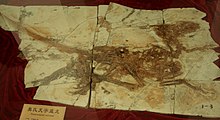Tianyuraptor
| Tianyuraptor | |
|---|---|

| |
| Holotype specimen | |
| Scientific classification | |
| Domain: | Eukaryota |
| Kingdom: | Animalia |
| Phylum: | Chordata |
| Clade: | Dinosauria |
| Clade: | Saurischia |
| Clade: | Theropoda |
| Family: | †Dromaeosauridae |
| Clade: | †Microraptoria |
| Genus: | †Tianyuraptor Zheng et al. 2009 |
| Species: | †T. ostromi
|
| Binomial name | |
| †Tianyuraptor ostromi Zheng et al., 2009
| |
Tianyuraptor is a
Etymology
The
Description

Tianyuraptor is a medium-sized dromaeosaurid that has several
The
Limbs
The forelimbs are comparatively short, being only 53% of the hindlimbs' length. This differs greatly from the known skeletal elements of other dromaeosaurids, most of which have relatively long forelimbs that are more than 70% of the hindlimbs' length.[1]
While Tianyuraptor is larger in size than all other known
Paleobiology
The stark difference in arm length compared to other dromaeosaurids implies that the function of the arms in Tianyuraptor was different from that of other dromaeosaurs. Members of the subfamily Microraptorinae, such as Microraptor, have been suggested to have been aerodynamic and may have glided.[9][10] Microraptorines are usually noted for their long and robust forelimbs and large, asymmetrical flight feathers. However, the shortened forelimbs, small furcula, and the transversely wide coracoid in Tianyuraptor suggest that it was not suited for aerodynamic gliding or flight.
Classification
A
See also
References
- ^ PMID 19692406.
- ^ Ostrom, John H. (1969). "Osteology of Deinonychus antirrhopus, an unusual theropod from the Lower Cretaceous of Montana". Bulletin of the Peabody Museum of Natural History. 30: 1–165.
- ^ "At Last, His Theory Flies". May 5, 2000. Olivia F. Gentile. Hartford Courant.
- ^ Senter, P.; Barsbold, R.; Britt, B. B.; Burnham, D. A. (2004). "Systematics and evolution of Dromaeosauridae (Dinosauria, Theropoda)". Bull. Gunma Mus. Nat. Hist. 8: 1–20.
- .
- doi:10.1002/gj.1045.
- ^ Currie, P. J. (1997). "Dromaeosauridae." Pp. 194–195 in Currie, P.J. and Padian, K. (eds.) Encyclopedia of Dinosaurs. San Diego: Academic Press.
- ^ Norell, M. A.; Makovicky, P.J. (1999). "Important features of the dromaeosaurid skeleton. Information from newly collected specimens of Velociraptor mongoliensis". American Museum Novitates (3282): 1–45.
- S2CID 1160118.
- PMID 17242354.
